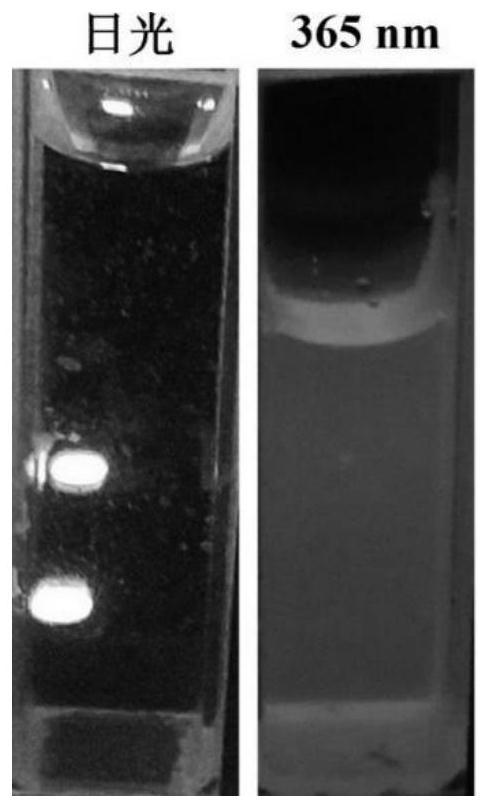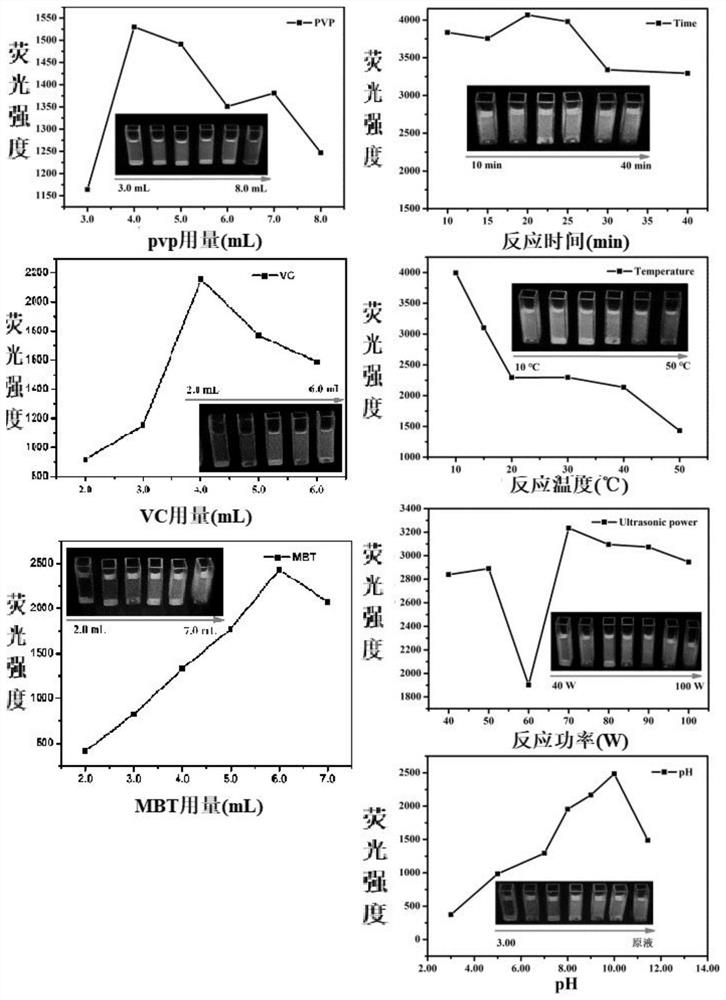Preparation method of polyvinylpyrrolidone-copper nanoclusters, product and application
A polyvinylpyrrolidone, copper nanotechnology, applied in nanotechnology, nano-optics, nanotechnology and other directions, can solve the problem of scarcity of bifunctional fluorescent copper nanoclusters, and achieve rapid reaction, short reaction time, and shortened reaction time. Effect
- Summary
- Abstract
- Description
- Claims
- Application Information
AI Technical Summary
Problems solved by technology
Method used
Image
Examples
Embodiment 1
[0055] Preparation of polyvinylpyrrolidone-copper nanoclusters
[0056] Pipette 2.0 mL of copper nitrate solution with a concentration of 1.0 mM, 4.0 mL of a solution of polyvinylpyrrolidone with a concentration of 0.069 mM, 6.0 mL of a solution of 2-mercaptobenzothiazole with a concentration of 0.1 mM, and 4.0 mL of a solution of ascorbic acid with a concentration of 0.1 mM Take it into a 25.0mL clean and dry glass reactor, mix it with ultrapure water at a constant volume, adjust the pH of the mixed solution to 10, place it in an ultrasonic cleaner with a power of 70W, and react at 10°C for 20min. The reaction solution was purified by dialysis with a 3500 dialysis bag to obtain a colorless aqueous solution of polyvinylpyrrolidone-copper nanocluster fluorescent probe, which was stored in a refrigerator at 4°C in the dark. The prepared fluorescent copper nanocluster solution is colorless under visible light, and produces strong orange fluorescence under 365nm ultraviolet light ...
Embodiment 2
[0058] Change the reaction conditions and the amount of raw materials for preparing copper nanoclusters, and judge the impact of the amount of PVP, MBT, VC, reaction temperature, time, power and pH on polyvinylpyrrolidone-copper nanoclusters (such as figure 2 Shown), and determine the optimal reaction conditions and dosage.
Embodiment 3
[0060] pH responsiveness test of polyvinylpyrrolidone-copper nanoclusters
[0061] Pipette 1.0mL of different pH (1.0-14.0) solutions into 2.0mL EP tubes, dilute to the mark with polyvinylpyrrolidone-copper nanoclusters; mL of EP tube diluted with ultrapure water to the mark as a control. Measure the fluorescence intensity of all solutions at excitation wavelength of 322nm and emission wavelength of 582nm.
[0062] image 3 It shows that the fluorescence intensity of polyvinylpyrrolidone-copper nanoclusters is quenched in different pH solutions, and its orange fluorescence gradually weakens under the irradiation of 365nm ultraviolet lamp. Depend on Figure 4 A shows that at different pH values, the fluorescence intensity of polyvinylpyrrolidone-copper nanoclusters at 580nm is gradually weakened or even quenched. Depend on Figure 4 B shows that in a neutral or alkaline environment, polyvinylpyrrolidone-copper nanoclusters have fluorescence intensity, and the fluorescence ...
PUM
 Login to View More
Login to View More Abstract
Description
Claims
Application Information
 Login to View More
Login to View More - R&D
- Intellectual Property
- Life Sciences
- Materials
- Tech Scout
- Unparalleled Data Quality
- Higher Quality Content
- 60% Fewer Hallucinations
Browse by: Latest US Patents, China's latest patents, Technical Efficacy Thesaurus, Application Domain, Technology Topic, Popular Technical Reports.
© 2025 PatSnap. All rights reserved.Legal|Privacy policy|Modern Slavery Act Transparency Statement|Sitemap|About US| Contact US: help@patsnap.com



